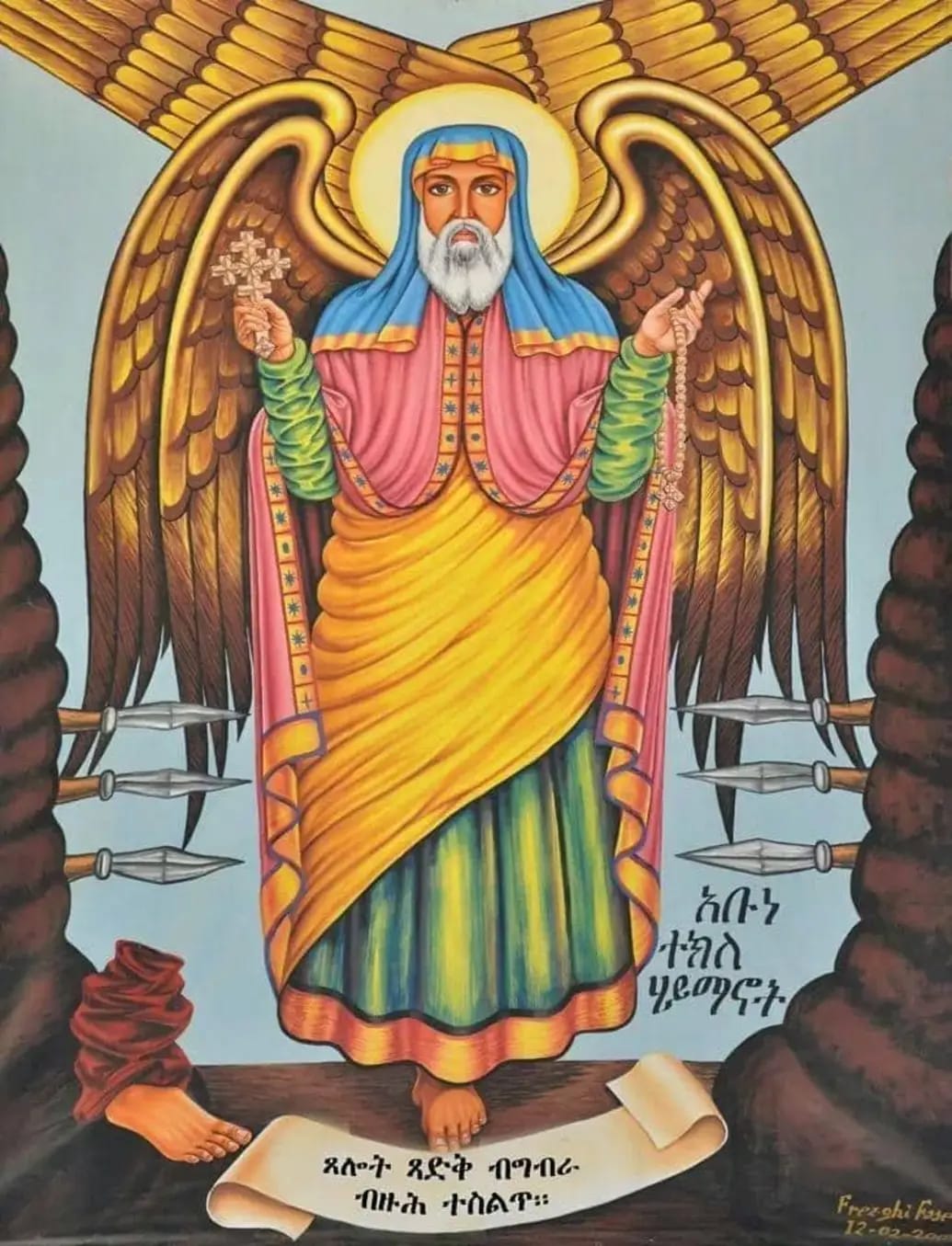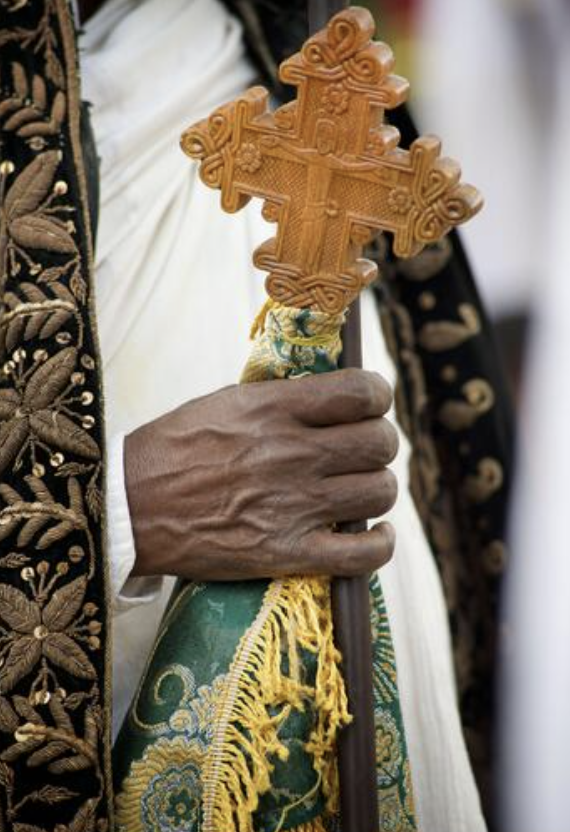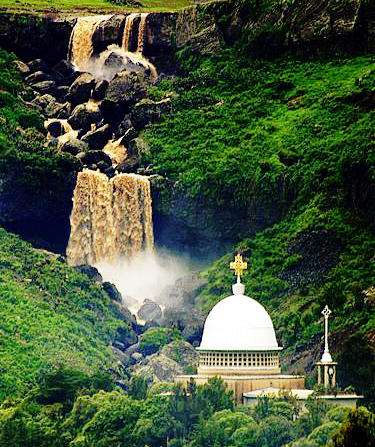Abune Teklehaymanot

Saint Abune Teklehaymanot (አቡነ ተክለሃይማኖት) was born on December 24, 1197, in North Shwa, Ethiopia, to Priest Tsegazeab (ጸጋዘአብ) which means “Grace of God” and his mother Egzi’eharaya (እግዚእሃረያ) which means “Choice of God”. On the third day after his birth, a miracle occurred. The newborn child left his mother’s arms and spoke the words, “One Holy Father, One Holy Son, One Holy Spirit.” On the 40th day, he was brought to the church and baptized with the name Fshatsion (ፍስሃጽዮን).
When he was one year and three months old, there was a severe drought in the Shoa region, causing great hunger among the people. His father, Priest Tsegazeab, prayed in the temple for food and water for the feast of St. Michael, while his mother stood weeping at the door of their house. The child, so young, asked his mother to bring some flour. Miraculously, he also filled the oil jar, enabling them to celebrate St. Michael’s feast.
He was raised with the teachings of the holy scriptures until he was seven years old. At the age of fifteen, his father took him to Pope Kyrillos of Egypt, who was also the bishop of Ethiopia. One night, Archangel Michael appeared in a dream to Pope Kyrillos and told him that a dark-skinned man would come the next day and kneel before him. This man had a blessed son, chosen for heaven and great in the eyes of God. “Ordain him as a deacon, and let him go in peace,” said Michael. When they saw him, they accepted him and ordained him as a deacon. Saint Abune Teklehaymanot learned horseback riding and hunting, as was common in his environment.
One day, while hunting with his companions, Saint Michael appeared and said, “You will no longer hunt animals, but people. God has given you the authority to heal the sick, cast out demons, and raise the dead. Your name will be Teklehaymanot, not FsehaTsion, which means ‘Plant of the Father, Plant of the Son, Plant of the Holy Spirit.'” The Lord Jesus Christ also appeared and said, “I have given you a new name through Michael, and I have made you a new apostle to send you to a land where the apostles have not reached.”
At the age of 22, he went to Abba Kerlos and received the priesthood. He began serving in the same temple as his father. After the death of his mother and then his father, he sold everything he had and gave it to the poor, leaving their house open. Many followed him, believed, and were baptized in the name of Lord Jesus after witnessing the many miracles he performed. In the vicinity of Bulga, there were many witches and idol worshipers who believed in wood and worshipped the sea. Saint Abune Teklehaymanot began to teach them, but the people refused to listen and forbade him from preaching the gospel. However, he went with faith to the tree that the people worshipped, and the people bowed to it and made offerings.

When he and the people approached the tree, Satan, worshipped by the villagers, began shouting, “Do not bring this man to me.” The villagers left him and went to the tree, but Teklehaymanot extended his hands toward the east and prayed to his Creator for his people: “O Lord, crush this Satan who has ruled over your creation under our feet. Expose the shame of this Satan, O God, and make your name known in this assembly. Let your works be known, and let them see your greatness.” He then returned to the tree, where the people worshipped, and commanded it: “O tree, where Satan dwells and misleads the people, I command you to rise from where you are and come to me in the name of Jesus Christ, in whom I believe and worship.” The people bowed to the tree, but the tree began to move as if it had legs and stood where Teklehaymanot was. The devil residing in the tree shouted, “You wicked man, you have come to take my servants away.” Then Saint Michael descended like lightning from heaven and strangled Satan. At that moment, Satan cried out, “Michael, do not destroy me before my time has come.” The villagers then approached Teklehaymanot, falling at his feet, saying, “O Father of the Light of Life, lead us to the beloved path of the Gospel.” Both young and old gathered and said, “We also believe in the God you believe in.” Teklehaymanot went to the river ‘Komst,’ blessed the water, and baptized them in the name of the Father, the Son, and the Holy Spirit.
They traveled to many places, performed many miracles, and converted the people from idolatry to the Christian faith. They reached a Gurage town called Tilat. The area was ruled by a sorcerer king. Teklehaymanot entered and struck the sorcerer until blood came from his mouth and nose. They threw him at the foot of the hill, thinking he was dead; but Saint Michael gave him strength again and raised him up. He became strong again and began to teach the gospel to the sorcerer king and the people. But once again, they showed strong resistance, upon which he said, ‘I command you in the name of the Lord, not in my name, O earth, to open and swallow them.’ The earth swallowed the king and the witches. King Motheloni of Damot also received him and threw him down twice, but Saint Michael caught him with his wings, and he stood up again and boldly preached the gospel to the people and the king. And because he had performed so many miracles, the people believed in the Lord, and King Motheloni was baptized and gave many possessions and money to the church. Tekle Haymanot stayed there for twelve years to teach Christianity. The bishop did not come out of Egypt for many years after the death of Abune Kerlos, who had granted Teklehaymanot the deaconship and priesthood. As a result, they encountered problems without a bishop to bless the ark for the churches they had established. At that time, when they prayed to the Lord Jesus Christ, God appeared to them and said, “I have consecrated you with a heavenly consecration, not with the consecration of bishops given by archbishops.” With this heavenly appointment, Abba Meron prepared and blessed the ark and founded many churches.
Teklehaymanot also joined a monastery and was vigilant in prayer, reciting 10 prayers with each Psalm, which amounted to 3650 prayers per day. After spending ten years on Mount Gol, Saint Michael appeared to him and said, “On Mount Haik, you will find a good man named Jesus Mua.” Saint Michael led him across the sea, and Tekle Haymanot walked on the sea as if it were land and reached the church. Abba Jesus Mua welcomed him and clothed him in monastic garments, which symbolized holiness and angels. There, they were engaged in much struggle and prayer and stayed by the Stephen Lake without food, except on Saturdays and Sundays. While he was engaged in this zeal, Saint Michael came, took him, and brought him to the third heaven. There, he witnessed the praise and song of the holy angels before God. A voice from the throne said, “May your portion come from these 24 priests of heaven.” They took golden censer vials and began to burn incense with the 24 priests of heaven. The Lord Jesus Christ promised him in His infallible Word: “I love you as you have loved me and have exalted your name. Everyone who believes in your prayer will be saved for your sake.” When he saw this heavenly life, his heart burned with love for this heavenly God. He was diligent in repeating David’s and other prayers, day and night.

After ten years by the lake, he came to the land of Tigray and met Abba Yohannes in the temple of Abune Aregawi, Debre Damo. They lived there for twelve years. Twelve years later, when they climbed the rope from the hill of Debre Damo to go to other places in Tigray, Satan, the enemy of the righteous, cut the rope. God gave them six wings of grace, and they flew with these wings that their God had given them, before the eyes of the monks who were with them. He blessed them during a visit to Hawzen and other monasteries in and around Tigray. They went to Jerusalem, led by a pillar of light, from Galilee, where the Lord Jesus Christ was born, to the Mount of Olives, where He ascended to heaven. After bathing in the Jordan River, during the reign of Abba Yohannes, patriarch of Egypt, he went to the monastery of Ascetes, where he received blessings from the monks. The monks of Debre Sihat also greeted him. When the Egyptian bishop, Abba Yohannes V, was sent to Ethiopia and asked him to divide and lead the people, Teklehaymanot humbly said, “Congratulations on your arrival, but I will return to my cave.”
Because the monastery founded by Abune Libanos was governed by a witch named Haras, Teklehaymanot banished her and made the mountain of Lebanon his cave in 1267. Teklehaymanot had a deep love for the Holy Virgin Mary and consecrated the forest where he lived, placing there the Ark of Mary. Through his prayers, water flowed in the forest, which is still known as Maye Teklehaymanot. After spending 29 years in this monastery, his body weakened due to old age. Although he could no longer preach the gospel on his journey, he prayed for many years without any support in his cave. Teklehaymanot stood on one leg and prayed for seven years. Afterward, the Lord Jesus Christ appeared to him and said, “You have finished your race and have suffered for my name.” When he was finally about to die, he gathered his disciples and gave them advice: “My children, not every monk will enter the heavenly kingdom. Be sure to remain faithful to your calling.”

He died peacefully on August 24, 1296, at the age of 99 years, 10 months, and 10 days. The monks buried him in his cave. Fifty-seven years after his death, around 1354, he appeared in a vision to the then abbot Abune Hizkia and asked him to bring his remains to the church. On May 12, they entered the cave with their disciples, found his bones, and brought them to the church on Mount Lebanon. His feast day is celebrated on December 24, his fracture on January 24, his conception on March 24, his transfiguration on May 12, and his death on August 24. May his blessings and prayers always be with us all in the Christian community. Amen.
All glory be to the Father, the Son, and the Holy Spirit.
All glory be to the Holy Virgin Mary.
On His glorious cross, Amen!

